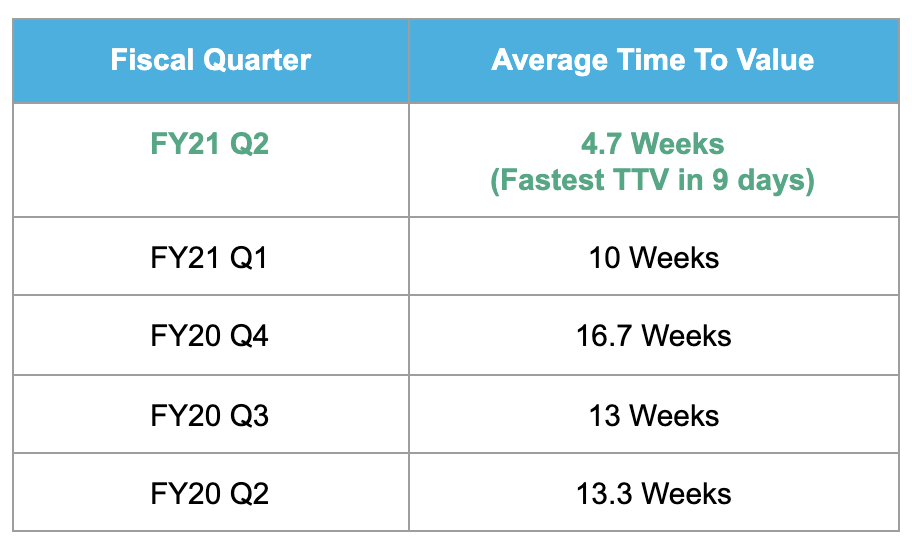COVID-19 has impacted businesses in innumerable ways. As company expectations rise, many expect to see a shorter time to value as finance departments scrutinize budgets to weather the recent unpredictability. Companies have already begun transforming their implementation processes to achieve this goal, but the current pandemic has created new urgency levels.
At Gainsight, we pride ourselves in using data to make better decisions for our customers and the community. Having completed 1000+ implementations at Gainsight, we have access to rich data and learnings to analyze how our Time To Value (TTV) has been trending over time and what causes delays in the metric. While there will always be dependencies on customer availability on project timelines, we wanted to make sure we’re doing everything within our control to reduce inefficiencies.
We looked at our methodology to identify where we see the most leakage on TTV to start addressing fundamental root causes.

We’ve summarized our findings into 3 major themes:
- Standard best-practice configurations: Some processes/features are common to almost all implementations (e.g., bringing CRM data into Gainsight, CSM sentiment health score). As a result of our expertise, companies want more prescriptive recommendations from Gainsight as the community’s thought leader.
- Phased methodology: Customers want a phased process with multiple value milestones versus waiting for one big rollout with all the value delivered at the end.
- Data integrations: Data integrations are an essential part of CSM teams’ value, and they typically took 30-40% of the total implementation time.
So, we started making some changes to the way we ran our implementations.
1. Standard best-practice configurations: The Professional Services team identified the most common configuration starting points applicable to most customer implementations:
- Setup CRM Connector – Connect to Salesforce, Dynamics CRM, HubSpot, and other CRMs
- Setup Data Integrations for Key CRM Data – Sync Jobs for Company, Person, User, and Opportunity
- Create Customer View – Set up the foundational views in Customer 360, including account information, contacts, opportunities, Timeline (for note-taking), etc.
- Define Health Scoring – Set up a basic manual health score measures to get started with associated weights
- Create starter workflows – Define a couple of workflows and notifications for CSMs – called Calls to Action (CTAs) in Gainsight
- Set-up Reports & Dashboards – Create out of the box reporting to draw out foundational insights and view metrics to manage your team
The Professional Services team then collaborated with the Product team to create a Configuration Wizard that enables the implementation consultant to guide their customer through these six elements in a structured manner. The consultant uses the Wizard on implementation calls/meetings with the customer to accelerate the onboarding process. Over time and with more in-product guides, this could also become a self-service wizard, but that was not the initial focus.

2. Phased methodology: We changed our methodology to give customers the option to launch very quickly and then iterate after the initial launch based on feedback from their users
- Agile: A practical onboarding approach to unlock value with the initial launch to users within the first few weeks of starting the implementation
- Out-of-the-Box Configuration: Align with prescriptive Customer Success best practices and resist the urge to create unnecessary customization whenever possible

This methodology is not for every customer. We’ll always have some customers that prefer to go live with one big launch, including all workflows and baked-in integrations. We’ll also have customers with mature and effective CS processes where the initial steps would include a Gainsight discovery and solutioning process. One approach is not better than the other. We now offer customers the option to choose their pace and adjust the methodology accordingly.
3. Data integrations: To make integrations more out of the box, the Product team has created a robust and growing collection of high-impact integrations and technology configurations, created in collaboration with our ecosystem of 50+ partners. These integrations are of two types:
- Built by Gainsight: Link your critical systems with Gainsight connectors, including support, billing/subscription, CRM, databases, etc.

- Built by Ecosystem Partners: Explore a collection of Gainsight integrations built by technology vendors across your customer success stack.

Now that we’ve implemented these changes to our implementation processes in Q1’21, our time to launch has dropped from an average of 13 weeks to 4 weeks—the fastest lasting nine days!


Our customer base is excited about the early results we are achieving together.
At Omada Health, a fast-growing public healthcare technology provider and leader in whole-person care, Gainsight’s Onboarding process exceeded their expectations. “We had expected at least two months for rollout but deployed a fully functional platform in just four weeks – including integration with Salesforce – and fully onboarded our CSMs two weeks later,” explains Liz Pittinger, Manager, Customer Success. You can learn more about their results from the full case study here.
Amanda Schmidt (VP of Customer Success) at PandaDoc, a leading document automation software provider, said, “We were excited to do our initial launch with Gainsight in 23 days. They’ve been a great partner as we’ve implemented!”
We were able to launch in three weeks at Malwarebytes – “We have had an outstanding experience partnering with Gainsight during our implementation and went “live” in just three weeks (including SFDC data, Timeline, and C360)! Our Strategic Engagement Manager and Solutions Architect have been fantastic partners, and it has felt like they have been working exclusively with us.” – Crystal Green, Director of Customer Success at Malwarebytes.
This initial progress delivering faster time to value is just the beginning of the journey. In our quest to keep improving, we’re reporting and reviewing this metric, monthly and quarterly, hopefully observing continuous improvement. Over time, we would like to see a vast majority of our newer customers going with a phased methodology—and we will update our progress on this critical metric as we continue to exceed our customer base’s expectations.

